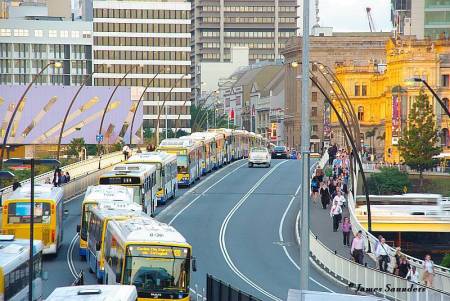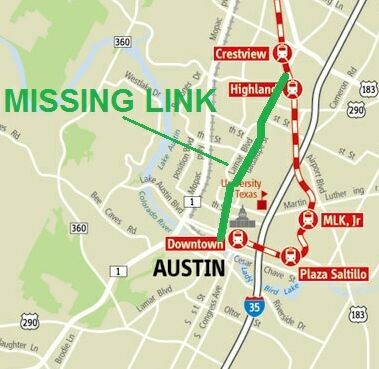
[Map: L. Henry. Click to enlarge.]
♦
Shown above is a map of the proposed Alternative Plan for a Phase 1 Urban Rail project, as developed by Dave Dobbs and Lyndon Henry. Note that this plan for 14.7 miles electric light rail transit (LRT) — serving both the Lamar-Guadalupe corridor and the eastside Red Line corridor — is projected to have a capital investment cost almost exactly the same as the City of Austin (COA) plan for a 5.5-mile line running from downtown, through the UT East Campus, Red River, and Hancock Center, to the Mueller site. Furthermore, the Alternative Plan also includes a branch serving Mueller.
This map was prepared in the autumn/winter of 2012 and, together with additional information, initially presented as a handout (Alternative Urban Rail Transit Plan for Austin) to a peer review group organized by the American Public Transportation Association in December. Here’s the narrative that accompanied the map:
♦
Introduction
• Peer Review needed wider scope — Should have been commissioned to evaluate route/design alternatives.
• City of Austin (COA) plan deficiencies — Would “work” as transit, but fails to serve the right corridor, fails to meet the highest priority, fails to provide the best value for money, and voter support is questionable. This reflects a difference of professional opinion, but we’ve been saying this since 2006!
Summary of Alternative Urban Rail Plan
• Overview — 14.7-mile electric LRT system connecting Crestview station with Convention Center via both an east and a west route.
• East route — Convert current DMU-operated MetroRail to electric LRT south of Crestview. There would be a cross-platform connection between LRT and MetroRail DMUs at Crestview; DMU service would proceed north and LRT service would proceed south via either route. The eastern branch follows the current MetroRail route southward to the Convention Center.
• Mueller spur — From the east line, a spur branch turns east at Manor Rd., proceeds from Manor to Airport Blvd., follows Airport north to Aldrich St., then turns east into the Mueller site to serve the northwestern area of the site and access a storage-maintenance facility.
• West route — From Crestview station, proceeds southward down Lamar Blvd. and Guadalupe St., serving this busy commercial-residential corridor, major neighborhoods such as Hancock and Hyde Park, the Triangle, and the West Campus of the UT area (4th-densest residential area in Texas). Route continues southward to 4th St., turning east to connect with the east branch of the system at the Convention Center station, thus forming a loop.
• Fleet & operations — System would have a fleet of 34 LRT cars, basically identical to the type of vehicle that COA’s plan envisions, operating in 1 to 2-car trains with minimum headways of 7.5 minutes. The system would be double-tracked except for the single-track east line section between Manor and Crestview. Schedule speed would average 13 mph.
• Ridership — Ridership projected to be 40,000 per day by 2025 (using ridership projections from 2000 LRT proposal, plus estimates for ridership on the east line and the Mueller spur). This is several times higher than COA’s estimate of rail ridership of 9,000-12,000 per day for their 5.5-mile line.
• Capital investment cost — Projected at $700 million, basically equivalent to the COA’s projected cost of $550 million for rail plus estimate of $150 million to convert the Lamar-Guadalupe MetroRapid bus route to partial “BRT” (out of total Project Connect budget of $500 million).
Alternative Urban Rail Plan vs. COA Plan
• Meets highest-priority traffic need — Alternative plan addresses most critical mobility problems of central city; COA’s plan does not even serve an existing corridor!
• TOD opportunities — Alternative plan serves far more opportunities for TOD (especially along Guadalupe, west downtown and West Campus, N. Lamar); COA plan taps relatively less TOD potential (Mueller site now developing without TOD). [TOD doesn’t necessarily mean mega-densities, but rather design that orients to public transport; furthermore, supporters of the Alternative Plan insist that any proposed TOD protect neighborhood livability and historic features, be consistent with neighborhood plans, and have the support of neighborhood consensus.]
• Much higher ridership — Alternative plan offers potential of 2-3 times higher ridership than COA plan.
• Better value for money — Alternative plan provides nearly 3 times as much rail route mileage as COA’s Urban Rail-plus-“BRT” plan, at approximately the same cost.
♦
To access a copy of the original handout in Word .DOC format, click here:
Alternative Urban Rail Transit Plan for Austin








